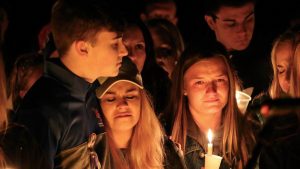Trump’s State of the Union address marks a deeply troubling back story to the narrative of American strength and success

People attend a vigil for the victims of a fatal shooting at Marshall County High School, Kentucky, after a 15-year-old accused of the fatal shooting was arrested on preliminary charges of murder and assault / AP
Donald Trump’s first State of the Union address is billed as a follow-through on his triumphalist message to the world from Davos 2018. America is “roaring back, open for business and competitive once again”, the US president declared. But is it really?
The statistical reading is good, which explains the buzzy sense of good cheer sweeping right the way round the world, with every major economy growing at a healthy clip. So, too, is the United States. Mr Trump boasted (without mentioning his predecessor’s contribution), the US stock market has grown $7 trillion, 2.4 million new jobs have been created and US unemployment is at a new low “since my election”. And the massive regulatory rollback in Mr Trump’s first year in office is expected to be attractive to corporate investors.
But there is also a deeply troubling back story to the narrative of American strength and success. Mr Trump’s sales pitch came three days after the 11th US school shooting this year. It came in the very week that America’s National Science Foundation reported the first drop since 2005 in international student enrolment in US computer science and engineering programmes. That Davos speech was delivered 10 days after a Gallup poll found the biggest annual rise in the number of Americans without healthcare insurance in nearly a decade. Meanwhile, American health professionals reported a steep rise in deaths from drug overdoses; it’s now said to be one every eight-and-a-half minutes.
No one can doubt the sincerity of Mr Trump’s self-belief as he issued his rousing call. “There has never been a better time to hire, to build, to invest and to grow in the United States,” he said. But is this, in the US president’s favoured description, fake news?
The evidence points to a deep malaise in the world’s richest country, composed of equal parts political disaffection and societal disconnection. Writer Umair Haque, who features on an authoritative ranking of the world’s most influential management thinkers, recently used a startling phrase to describe America in 2018. It is, he said, “the world’s first rich failed state”. Mr Haque explained his assertion with a rundown of the “social pathologies of collapse”: rampant gun violence, opioid overdosing, nomadic retirees who live in their cars and the lack of affordable healthcare. No other country, he pointed out, not even Afghanistan or Iraq, has the phenomenon of regular school shootings. And only in America do we find an “opioid epidemic”. All of these “ strange, weird and gruesome new diseases… that we have never really seen before in any modern society” are overlaid by gross indifference, he said. Americans live in a “predatory” society that just doesn’t “care enough to intervene”.
It is a harsh, slightly hyperbolic analysis and there will be many dissenting views. But the idea of a “rich failed state” — the world’s first rich failed state — bears some examination. The US is certainly not a failed state in that its government continues to control its territory and represent the country internationally, the mechanisms of domestic governance work in the usual way, taxes are collected and apportioned, US post functions efficiently as always and the state’s administrative and judicial routines and rituals remain intact.
And yet there is a decided sense of degeneration, a slow collapse under the weight of multiple self-inflicted crises. Even as a mythic selective greatness is invoked by Mr Trump and the US spends more on defence, gun deaths spiral, whole communities are vulnerable to drug abuse and racial and ethnic tensions rise. All of these have become the American story today, just as much as the more glorious ones from its recent past — so much so that even the US president took a day-and-a-half to respond to an incident involving a 15-year-old schoolboy shooting at his classmates and teachers in Kentucky.
Gun violence in the US has become like other forgotten conflicts, an inevitable tragedy impossible to properly mourn because the act of mourning is so repetitive, it feels mechanical. Like the recent spate of bomb blasts in Afghanistan, a state that is desperately trying not to fail, American shootings have become heartbreakingly familiar: bloody, pointless and seemingly unstoppable. And like those bombings, which are rarely reported internationally unless the toll is especially high or the circumstances exceptional, a shooting in the US attracts little attention now. The world has become inured, resigned to the inexplicably fatal rhythm of the American way of life in this century.
This is likely to take its toll — and not just on lives. It affects the way the world perceives the American dream. The Trump administration’s manifest hostility to non-European immigrants, skilled workers and visitors was probably the main reason large numbers of Indian, Saudi, Iranian and South Korean computer and engineering students elected not to come to the US in 2017. But surely the no-shows point to something else as well: a fear that the dream is turning into a nightmare, of which they want no part.
Originally published at www.thenational.ae

